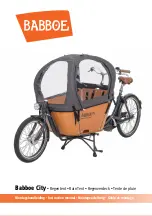
20
ENGLISH
saddle height needs to be adjusted. If your hips must rock for the heel to reach
the pedal, the saddle is too high. If your leg is bent at the knee with your heel on
the pedal, the saddle is too low.
Ask a bicycle dealer to set the saddle for your optimal riding position and to show
you how to make this adjustment. If you choose to make your own saddle height
adjustment:
• open the seat post cam action clamp (see Section 4.2 for cam action clamp
operation)
• raise or lower the seat post in the seat tube
• make sure the saddle is straight fore and aft
• close and check the seat post cam action clamp.
Once the saddle is at the correct height, make sure that the seat post does not
project from the frame beyond its embossed “Minimum Insertion” or “Maximum
Extension” mark.
WARNING: If your seat post is not inserted in the seat tube as described
in 3.2.1 above, the seat post may break, which could cause you to lose
control and fall.
2. Front and back adjustment. The saddle can be adjusted forward or back to
help you get the optimal position on the bike. Ask a bicycle dealer to set the
saddle for your optimal riding position and to show you how to make this
adjustment. If you choose to make your own front and back adjustment, make
sure that the clamp mechanism is clamping on the straight part of the saddle
rails and is not touching the curved part of the rails, and that you are using the
recommended torque on the clamping fastener(s) (Appendix B).
3. Saddle angle adjustment. Most people prefer a horizontal saddle; but some
riders like the saddle nose angled up or down just a little. A bicycle dealer can
adjust saddle angle or teach you how to do it. If you choose to make your own
saddle angle adjustment and you have a single bolt saddle clamp on your
seat post, it is critical that you loosen the clamp bolt suffi ciently to allow any
serrations on the mechanism to disengage before changing the saddle’s angle,
and then that the serrations fully re-engage before you tighten the clamp bolt
to the recommended torque (Appendix B).
WARNING: When making saddle angle adjustments with a single bolt
saddle clamp, always check to make sure that the serrations on the mating
surfaces of the clamp are not worn. Worn serrations on the clamp can allow
the saddle to move, causing you to lose control and fall.
• Always tighten fasteners to the correct torque. Bolts that are too tight
can stretch and deform. Bolts that are too loose can move and fatigue.
Summary of Contents for Leader
Page 4: ......
Page 18: ...18 ENGLISH...
Page 32: ...32 ENGLISH...
Page 46: ...46 FRAN AIS...
Page 75: ......
















































